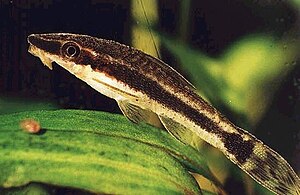Loricarioidei
| Loricarioidei | ||||||||||||
|---|---|---|---|---|---|---|---|---|---|---|---|---|

|
||||||||||||
| Systematics | ||||||||||||
|
||||||||||||
| Scientific name | ||||||||||||
| Loricarioidei | ||||||||||||
The Loricarioidei are a suborder of the catfish-like (Siluriformes). The group includes six non in South and Central America fish families astroblepus (Astroblepidae) which callichthyidae (Callichthyidae) which Nematogenyidae , the spined catfish (Scoloplacidae) which Slickheads (Trichomycteridae) and the eponymous loricariids (Cichlidae) , in Nelson (2006) also the African burbot catfish (Amphiliidae) as the most basic group of the Loricarioidei. Including the last family, 156 genera and 1187 species belong to the superfamily.
features
Like other catfish, most Loricarioidei have barbels . They can be scaly or, like the armored and calloused catfish, the spiky dwarf catfish and the armored catfish, armored with bone plates. Most species are flattened, the armored catfish rather squeezed sideways. Two features are given for the diagnosis of Loricarioidei, the reduced swim bladder , which is enclosed by a bone capsule formed from outgrowths of the first vertebrae (parapophyses), and the odontodes on the surface of the body and on the fin rays . These odontodes can pierce the skin on the gill covers of the armored catfish. The climbing catfish may use their odontodes as a sensory organ.
Systematics
The kinship group was traditionally placed in the suborder Siluroidei, to which all catfish families except the primitive catfish (Diplomystidae) belong. In a more recent molecular biological analysis they were compared as the suborder Loricarioidei (without the burbot catfish) as a sister group to the primitive catfish and all other catfish families (suborder Siluroidei). In this analysis, the burbot catfish are placed in a clade called the “Big Africa” group. B. the Mochokidae (Fiederbartwelse) and the Zitterwelse (Malapteruridae) belong.
From morphological data it is concluded that the loach catfish and Nematogenys inermis first diverged; both taxa are possibly sister groups. This relationship has never been confirmed or refuted by molecular biological studies. Then the armored catfish and callous catfish developed, then the spiky dwarf catfish and finally armor and climbing catfish. Within the Loricarioidei, a trend towards an increasingly complex jaw morphology can be observed, which ultimately led to the development of the armored catfish, which have the most modern jaws.
A cladogram clarifies the family relationships:
| Loricarioidei |
|
||||||||||||||||||||||||||||||
|
|
distribution and habitat
The Loricarioidei occur in freshwater biotopes of the Neotropics , in South America , Panama and Costa Rica . Most species live in fast flowing waters. Armored catfish and climbing catfish have therefore developed a sucking mouth with which they can attach themselves to the rocky ground. Climbing catfish even have the ability to climb up waterfalls with the help of their suckers and pelvic fins.
ecology
The Loricarioidei are a very diverse monophyletic group. They show a wide range of adaptation in terms of their morphology , colonize many different freshwater habitats and occupy different places in the food chain . The group includes herbivores, omnivores, parasites ( Vandelliinae ) and wood-eating species ( Panaque ). With around 700 species (new species are discovered every year), the armored catfish are by far the most diverse, successful and diverse family in the entire superfamily.
Individual evidence
- ↑ a b c d e f g Joseph S. Nelson: Fishes of the World . John Wiley & Sons , Inc, 2006, ISBN 0-471-25031-7 .
- ↑ a b c d e f Scott A. Schaefer, Lauder, George V .: Historical Transformation of Functional Design: Evolutionary Morphology of Feeding Mechanisms in Loricarioid Catfishes . In: Society of Systematic Biologists (Ed.): Systematic Zoology . 35, No. 4, 1986, pp. 489-508. JSTOR 2413111 . doi : 10.2307 / 2413111 .
- ^ Roberto E. Reis: Callichthyidae. Armored Catfishes . Tree of Life Web Project . May 14, 1998. Retrieved July 4, 2007.
- ^ Scott A. Schaefer, Buitrago-Suárez, Uriel Angel: Odontode Morphology and Skin Surface Features of Andean Astroblepid Catfishes (Siluriformes, Astroblepidae) . ( PDF ) In: Journal of Morphology . 254, No. 2, 2002, p. 139. doi : 10.1002 / jmor.10024 . PMID 12353298 .
- ↑ a b c JP Sullivan, Lundberg JG; Hardman M: A phylogenetic analysis of the major groups of catfishes (Teleostei: Siluriformes) using rag1 and rag2 nuclear gene sequences . In: Mol Phylogenet Evol. . 41, No. 3, 2006, pp. 636-62. doi : 10.1016 / j.ympev.2006.05.044 . PMID 16876440 .
- ↑ John G. Lundberg: Siluriformes. Catfishes . Tree of Life Web Project . January 20, 2003. Retrieved September 12, 2011.
- ↑ JA Nelson, Wubah, DA; Whitmer, ME; Johnson, EA; Stewart, DJ: Wood-eating catfishes of the genus Panaque : gut microflora and cellulolytic enzyme activities . In: Journal of Fish Biology . 54, 1999, pp. 1069-1082. doi : 10.1111 / j.1095-8649.1999.tb00858.x .